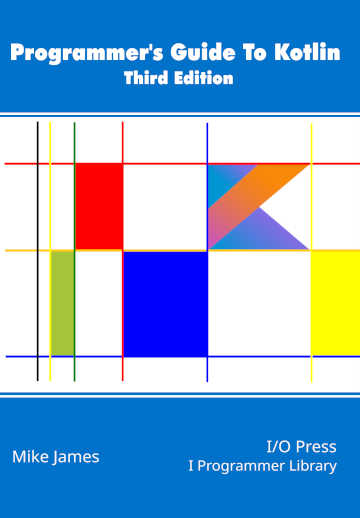|
Page 1 of 2 Kotlin has exceptions - but what do you do with them? In this extract from The Programmers Guide To Kotlin by Mike James, we look at and its approach to exceptions and how to work with them.
Programmer's Guide To Kotlin Third Edition

You can buy it from: Amazon
Contents
- What makes Kotlin Special
- The Basics:Variables,Primitive Types and Functions
- Control
Extract: If and When
- Strings and Arrays
- The Class & The Object ***NEW!
- Inheritance
- The Type Hierarchy
- Generics
- Collections, Iterators, Sequences & Ranges
Extract: Iterators & Sequences
- Advanced functions
- Anonymous, Lamdas & Inline Functions
- Data classes, enums and destructuring
Extract: Destructuring
- Exceptions, Annotations & Reflection
- Coroutines
Extract: Coroutines
- Working with Java
Extract: Using Swing
- Compose Multiplatform
Extract: Compose Layout
<ASIN:B0D8H4N8SK>
Exceptions are a way of dealing with “out of band” behavior and could almost be considered to be part of metaprogramming. All three qualify for the status of something that you tackle when you have become completely comfortable with the main features of Kotlin.
Exceptions
Exceptions in Kotlin work in the way that they do in most modern languages, and of course Java. There are some interesting differences, however.
An exception is an error or a fault condition that is difficult to test for before it happens, but it has to be admitted that many exceptions are simply excuses not to test for the error.
For example, division by zero is an error that can usually be tested for beforehand:
if(b!=0) result=a/b
but in most cases it is treated an exception to the normal flow of control within the program.
The whole idea of exception handling is that it can provide a sort of alternative flow of control for your code so that you can express your algorithm in two clear parts – one for what happens when everything works, and another for what happens when there is a problem.
Exceptions also allow you to unwind the call stack to get back to an earlier condition that represents things before the error occurred so that you can have another attempt.
In Kotlin and Java exceptions are handled using a try-catch block:
try{
var result=a/b
}
catch(e:ArithmeticException){
println(e)
}
The statements within the try block are executed and control passes out of the try-catch to the next instruction if everything works.
If there is a problem while the program is running, then an exception is thrown and the catch blocks are checked in the order they occur for one that matches the type of the exception object. Exceptions "throw" an exception object and all exception objects are descended from Throwable.
Which exception a catch block handles is determined by the type of the catch parameter. If the exception object is of that type or a subtype then the catch block is executed and the program continues after the try-catch block.
There can be multiple catch blocks after a try and each one can handle a different possible exception. In this way the catch blocks form a multi-way selection, with the same form as a when, for what is to happen based on the type of the thrown object.
Notice that unlike Java, Kotlin doesn't currently support multi-catch expressions. That is, you can't use a single catch to handle more than one type of exception if they are not derived classes.
If the exception is unhandled, i.e. there is no catch block, then a return is executed and the next function up the call stack is checked for an exception handler that accepts the exception. If one is not found a return is executed and the search for an exception handler continues. Eventually the top level is reached and if no exception handler is found the program halts with a run-time exception which is reported to the user. This unwinding of the call stack is the reason that an exception can get back to an early part of the program that can try the task again or give better error information to the user.
For example, if we define a function to do the division:
fun div(a:Int,b:Int):Int=a/b
and call it from within a try-catch block:
try{
div(1,0)
}
catch(e:ArithmeticException){
println(e)
}
Then the exception occurs in the div function, but because it is unhandled it is passed up to the main program which does handle it.
|
